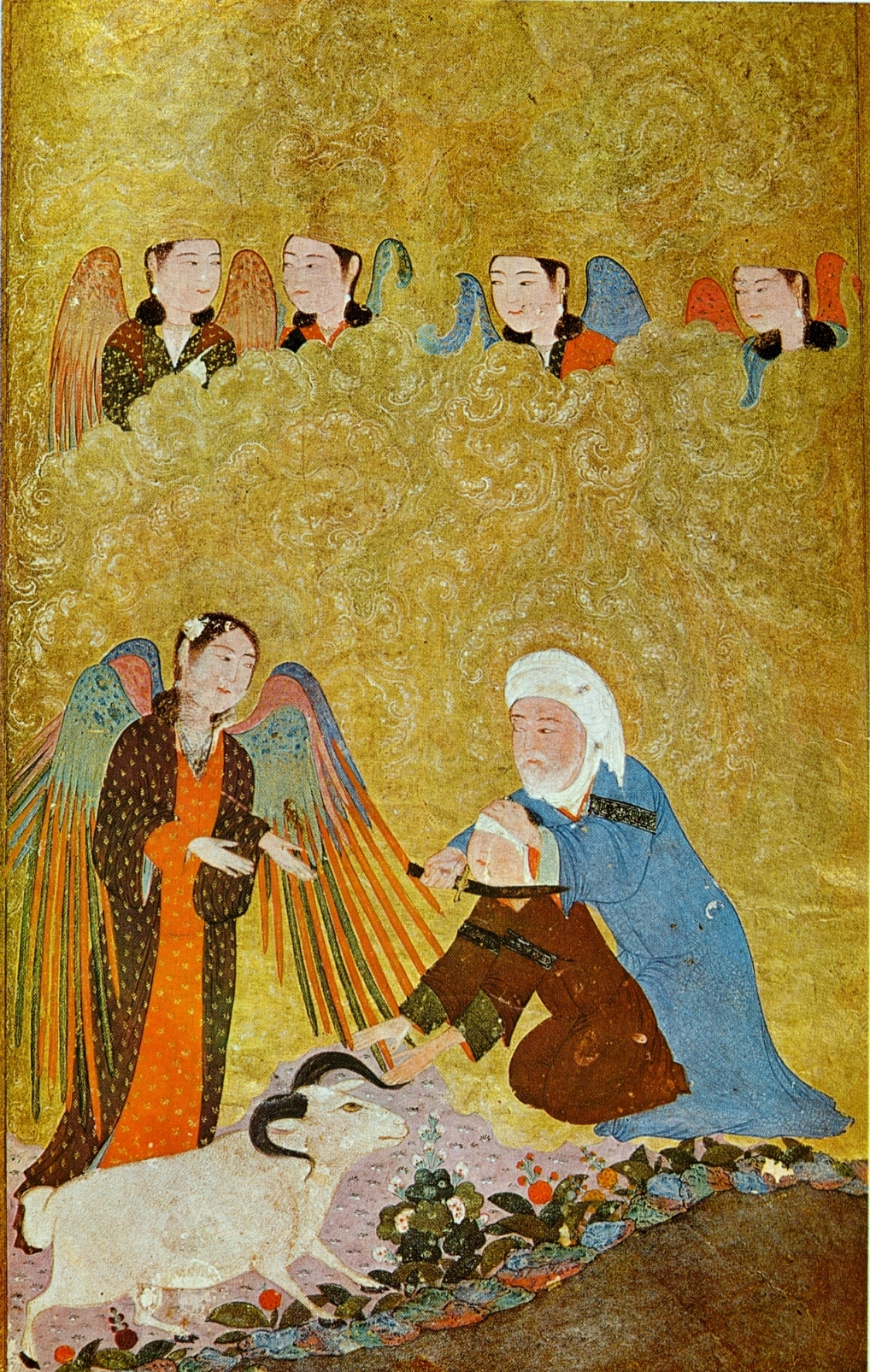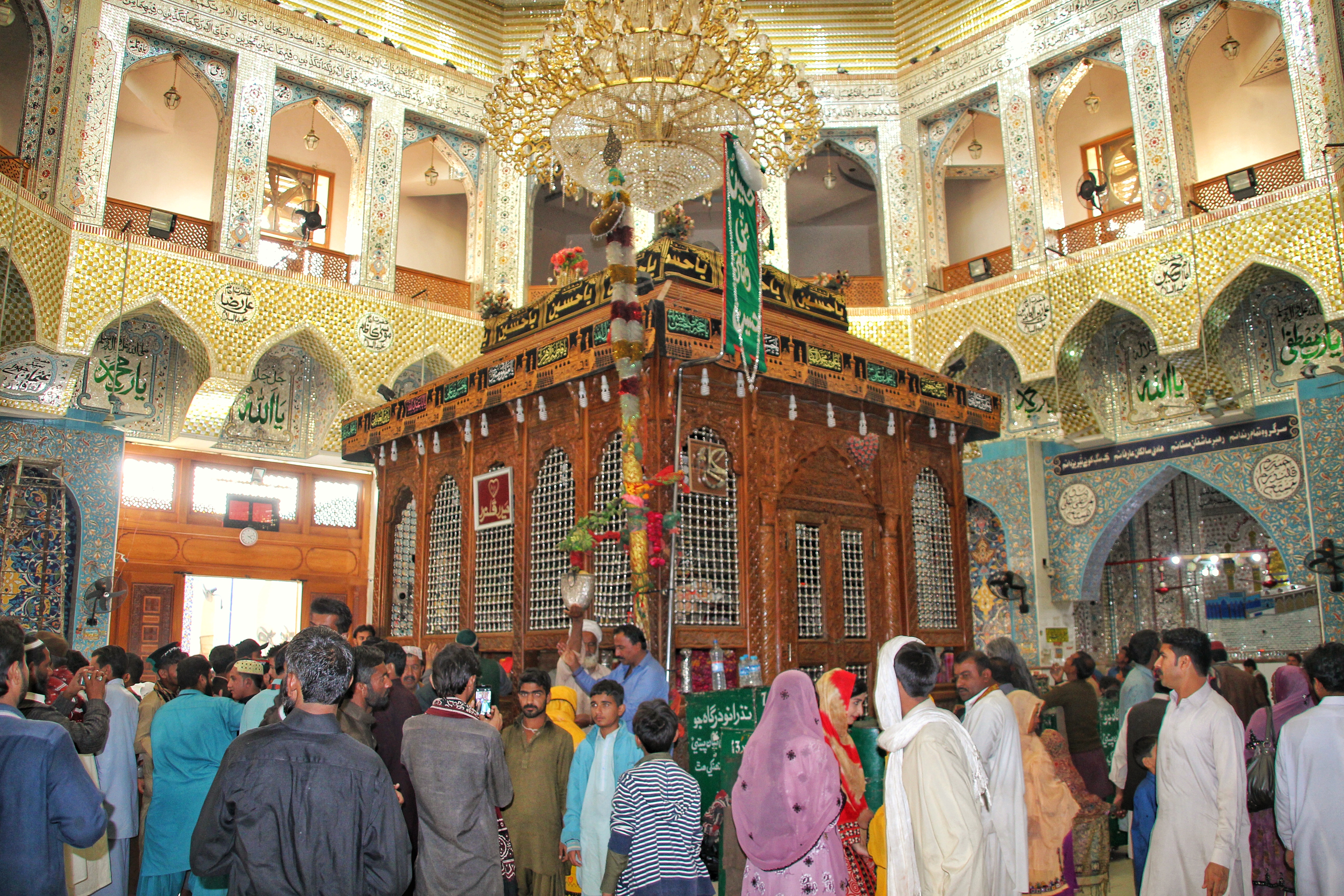|
Shrine Of Ibrahim
The Shrine of Ibrahim, known locally as Lal Shahbaz Dargah, was built around 1160 in Bhadresar in Kutch district, Gujarat, India. It is one of the earliers extant Islamic monuments in India. The shrine is mistakenly attributed to Lal Shahbaz Qalandar, whose shrine is instead located in Pakistan. Shrine The shrine, in a small walled enclosure, has a square pyramid shaped dome, round in the inside and supported on eight pillars set against the wall. The roof of the porch is flat is divided in 9×3 small squares, each with lotus flowers inside. Round the architrave, above the vine-ornamented wall-head course, there is a deep line of Arab inscription in large square Kufic characters, and on the right-end of the wall there are two lines of inscription. In the court some graves also have Kufic inscriptions. These epigraph constructed in 1160 marked the first use of Kufic script in India. According to an inscription in the monument, it is a shrine to Ibrahim Ibrahim ( ar, إبراهي ... [...More Info...] [...Related Items...] OR: [Wikipedia] [Google] [Baidu] |
Bhadresar
Bhadresar or Bhadreshwar is a village in Mundra Taluka, Kutch district of Gujarat, India. It is about 27 km from Taluka headquarters Mundra and barely a kilometer away from the seashore. History Bhadreshwar is the site of the ancient city of Bhadravati.Bhadravati is mentioned in epic ''Mahabharata''. It is mentioned in the works of Kantavijay, a Jain monk. The earliest source of information regarding this place is an inscription on the Ajitnath statue in Vasai Jain temple which records Samvat 622 (555 AD) which may be marking Samvat 1622 (1565 AD) also. The Vasai Jain Temple is said to have been founded in the 21st year of the Vairat era, and dedicated to Vasai by Siddhasen of the race of Hari. His successors were Mahasen, Narsen, Bhojraj, Vanraj, Sarangdev, Virasen, and Harisen, who lived in the time of Vikram (57 BC). Harisen had left his kingdom to his widow Lilavati. Lilavati was succeeded by his nephew Kirtidhara. Then came Dharnipal, Devdatt and Danjiraj. In th ... [...More Info...] [...Related Items...] OR: [Wikipedia] [Google] [Baidu] |
Gujarat
Gujarat (, ) is a state along the western coast of India. Its coastline of about is the longest in the country, most of which lies on the Kathiawar peninsula. Gujarat is the fifth-largest Indian state by area, covering some ; and the ninth-most populous state, with a population of 60.4 million. It is bordered by Rajasthan to the northeast, Dadra and Nagar Haveli and Daman and Diu to the south, Maharashtra to the southeast, Madhya Pradesh to the east, and the Arabian Sea and the Pakistani province of Sindh to the west. Gujarat's capital city is Gandhinagar, while its largest city is Ahmedabad. The Gujaratis are indigenous to the state and their language, Gujarati, is the state's official language. The state encompasses 23 sites of the ancient Indus Valley civilisation (more than any other state). The most important sites are Lothal (the world's first dry dock), Dholavira (the fifth largest site), and Gola Dhoro (where 5 uncommon seals were found). Lothal i ... [...More Info...] [...Related Items...] OR: [Wikipedia] [Google] [Baidu] |
Abraham In Islam
According to the Islamic faith, Abraham ( ar, إِبْرَاهِيْمُ, ʾIbrāhīm, ) was a Prophets and messengers in Islam, prophet and messenger of God in Islam, God, and an ancestor to the Ishmaelites#Quran, Ishmaelite Arabs and Twelve Tribes of Israel#In Islam, Israelites. Abraham plays a prominent role as an example of faith in Judaism, Christianity, and Islam. In Muslim belief, Abraham fulfilled all the commandments and trials wherein God nurtured him throughout his lifetime. As a result of his unwavering faith in God in Islam, God, Abraham was promised by God to be a leader to all the nations of the world. The Quran extols Abraham as a model, an exemplar, obedient and not an idolater. In this sense, Abraham has been described as representing "primordial man in universal surrender to the Divine Reality before its fragmentation into religions separated from each other by differences in form". Muslims believe that the Kaaba in Mecca was built by Abraham and his son Ishmael a ... [...More Info...] [...Related Items...] OR: [Wikipedia] [Google] [Baidu] |
Lal Shahbaz Qalandar
Hazrat Sayyid Usman Marwandi, (1177 - 19 February 1274) popularly known as Lal Shahbaz Qalandar (), was a Sufi saint and poet of present-day Pakistan and Afghanistan. Lal Shahbaz Qalandar was born in Marwand, Sistan to a family from Baghdad. He eventually settled in Sindh and helped many people in converting to Islam and was revered by the local Sindhi population. Lal Shahbaz Qalandar had also been reputed for performing many miracles and was seen as a very holy figure in Sindh. The 19th century spiritual Sufi Manqabat ''Dama Dam Mast Qalandar'' is dedicated to Lal Shahbaz Qalandar and is widely popular in the sub-continent. Names He is called ''Lal'' ("ruby-coloured") because of the ruby-like glow on his face/forehead and " Shahbaz" to denote a noble and divine spirit and "Qalandar" as he was a wandering spiritual man. Lal Shahbaz Qalandar is sometimes called ''Jhulelal'' (Sindhi: ). The term Jhulelal means "red bridegroom". According to the Garland Encyclopedia, Lal ... [...More Info...] [...Related Items...] OR: [Wikipedia] [Google] [Baidu] |
Shrine Of Lal Shahbaz Qalandar
The Shrine of Lal Shabaz Qalandar ( ur, ; sd, لال شهباز قلندر جي مزار) is a shrine and mausoleum dedicated to the 13th century Muslim and Sufi saint, Lal Shahbaz Qalandar. The shrine is located in Sehwan Sharif, in the Pakistani province of Sindh. The shrine is one of the most important in Pakistan, and attracts up to one million visitors annually. History The shrine's construction was started under the reign of Shah Tughluq, who ordered that the saint's remains be enshrined in Sehwan Sharif. The tomb complex was built in 1356 C.E., though it has been expanded several times since its founding. Ibn Battuta mentions the shrine during his travels to the region in the mid-fourteenth century. In 1639, the shrine was greatly expanded under the rule of Mirza Jani of the Tarkhan dynasty. Though the shrine was founded centuries ago, its popularity expanded in the late 20th century. On 16 February 2017, the Islamic State of Iraq and the Levant – Khorasan Province cl ... [...More Info...] [...Related Items...] OR: [Wikipedia] [Google] [Baidu] |
Pakistan
Pakistan ( ur, ), officially the Islamic Republic of Pakistan ( ur, , label=none), is a country in South Asia. It is the world's List of countries and dependencies by population, fifth-most populous country, with a population of almost 243 million people, and has the world's Islam by country#Countries, second-largest Muslim population just behind Indonesia. Pakistan is the List of countries and dependencies by area, 33rd-largest country in the world by area and 2nd largest in South Asia, spanning . It has a coastline along the Arabian Sea and Gulf of Oman in the south, and is bordered by India to India–Pakistan border, the east, Afghanistan to Durand Line, the west, Iran to Iran–Pakistan border, the southwest, and China to China–Pakistan border, the northeast. It is separated narrowly from Tajikistan by Afghanistan's Wakhan Corridor in the north, and also shares a maritime border with Oman. Islamabad is the nation's capital, while Karachi is its largest city and fina ... [...More Info...] [...Related Items...] OR: [Wikipedia] [Google] [Baidu] |
Kufic
Kufic script () is a style of Arabic script that gained prominence early on as a preferred script for Quran transcription and architectural decoration, and it has since become a reference and an archetype for a number of other Arabic scripts. It developed from the Arabic alphabet in the city of Kufa, from which its name is derived. Kufic script is characterized by angular, rectilinear letterforms and its horizontal orientation. There are many different versions of Kufic script, such as square Kufic, floriated Kufic, knotted Kufic, and others. History Origin of the Kufic script Calligraphers in the early Islamic period used a variety of methods to transcribe Qur’an manuscripts. Arabic calligraphy became one of the most important branches of Islamic Art. Calligraphers came out with the new style of writing called Kufic. Kufic is the oldest calligraphic form of the various Arabic scripts. The name of the script derives from Kufa, a city in southern Iraq which was considere ... [...More Info...] [...Related Items...] OR: [Wikipedia] [Google] [Baidu] |
Epigraphy
Epigraphy () is the study of inscriptions, or epigraphs, as writing; it is the science of identifying graphemes, clarifying their meanings, classifying their uses according to dates and cultural contexts, and drawing conclusions about the writing and the writers. Specifically excluded from epigraphy are the historical significance of an epigraph as a document and the artistic value of a literature, literary composition. A person using the methods of epigraphy is called an ''epigrapher'' or ''epigraphist''. For example, the Behistun inscription is an official document of the Achaemenid Empire engraved on native rock at a location in Iran. Epigraphists are responsible for reconstructing, translating, and dating the trilingual inscription and finding any relevant circumstances. It is the work of historians, however, to determine and interpret the events recorded by the inscription as document. Often, epigraphy and history are competences practised by the same person. Epigraphy ... [...More Info...] [...Related Items...] OR: [Wikipedia] [Google] [Baidu] |
Islamic Shrines
Islam (; ar, ۘالِإسلَام, , ) is an Abrahamic monotheistic religion centred primarily around the Quran, a religious text considered by Muslims to be the direct word of God (or ''Allah'') as it was revealed to Muhammad, the main and final Islamic prophet.Peters, F. E. 2009. "Allāh." In , edited by J. L. Esposito. Oxford: Oxford University Press. . (See alsoquick reference) " e Muslims' understanding of Allāh is based...on the Qurʿān's public witness. Allāh is Unique, the Creator, Sovereign, and Judge of mankind. It is Allāh who directs the universe through his direct action on nature and who has guided human history through his prophets, Abraham, with whom he made his covenant, Moses/Moosa, Jesus/Eesa, and Muḥammad, through all of whom he founded his chosen communities, the 'Peoples of the Book.'" It is the world's second-largest religion behind Christianity, with its followers ranging between 1-1.8 billion globally, or around a quarter of the world's pop ... [...More Info...] [...Related Items...] OR: [Wikipedia] [Google] [Baidu] |







.jpg)